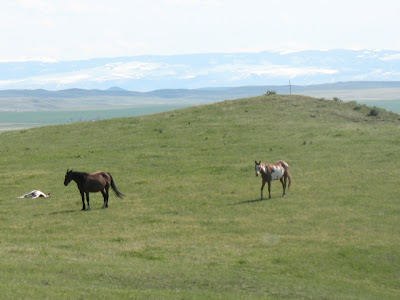Our destination for the night was Buffalo, Wyoming, but our main stop for the day was Little Bighorn Battlefield National Monument.
It was a great visit.
In addition to the information on Custer's Last Stand, the site is also a national cemetery. If you've never been to one, they are solemn, beautiful cemeteries with rows and rows of simple white markers.
The battlefield site was very interesting. While I knew the basics of the battle, the battlefield itself allows you to follow the fight (which took place over about a five mile stretch) step-by-step from the time Custer spotted the huge gathering of Indians encamped alongside the river.
You drive out five miles past the information center, then retrace the major battle points, culminating with Custer's last stand back near the monument entrance. We spent a couple of hours, and could have spent a whole day. It was fascinating.
The scenery was also something else. Horses roamed around, and we spotted various critters and wildlife (no rattlers even though signs warned about them).
Highly recommend a stop if you're ever out this way.
Enjoy the pictures.

 Hot tub after nice morning dip in Billings, MT. Nice town.
Hot tub after nice morning dip in Billings, MT. Nice town.
 Scenery along I-90 (which was going more south than east) was miles and miles of empty, rolling hills and pasture.
Scenery along I-90 (which was going more south than east) was miles and miles of empty, rolling hills and pasture.

 Entering Crow Country.
Entering Crow Country. Prairie Dogs and wildlife were spotted often.
Prairie Dogs and wildlife were spotted often.

 Beautiful horses all around as we got into Little Bighorn monument.
Beautiful horses all around as we got into Little Bighorn monument.



 I didn't even realize the battlefield was also a national cemetery (and at first thought these were the markers of the soldiers who died in the battle).
I didn't even realize the battlefield was also a national cemetery (and at first thought these were the markers of the soldiers who died in the battle).



















 The Indian Wars and the era of the Old West was so brief (really about late 1860s to 1880s) ... within a decade or so of this battle, some of the great American Indian warriors and chiefs (American Horse for example) would send their sons to Carlisle Indian School ... where some would play football for Glenn "Pop" Warner (who also coached the Georgia Bulldogs briefly).
The Indian Wars and the era of the Old West was so brief (really about late 1860s to 1880s) ... within a decade or so of this battle, some of the great American Indian warriors and chiefs (American Horse for example) would send their sons to Carlisle Indian School ... where some would play football for Glenn "Pop" Warner (who also coached the Georgia Bulldogs briefly).







No comments:
Post a Comment